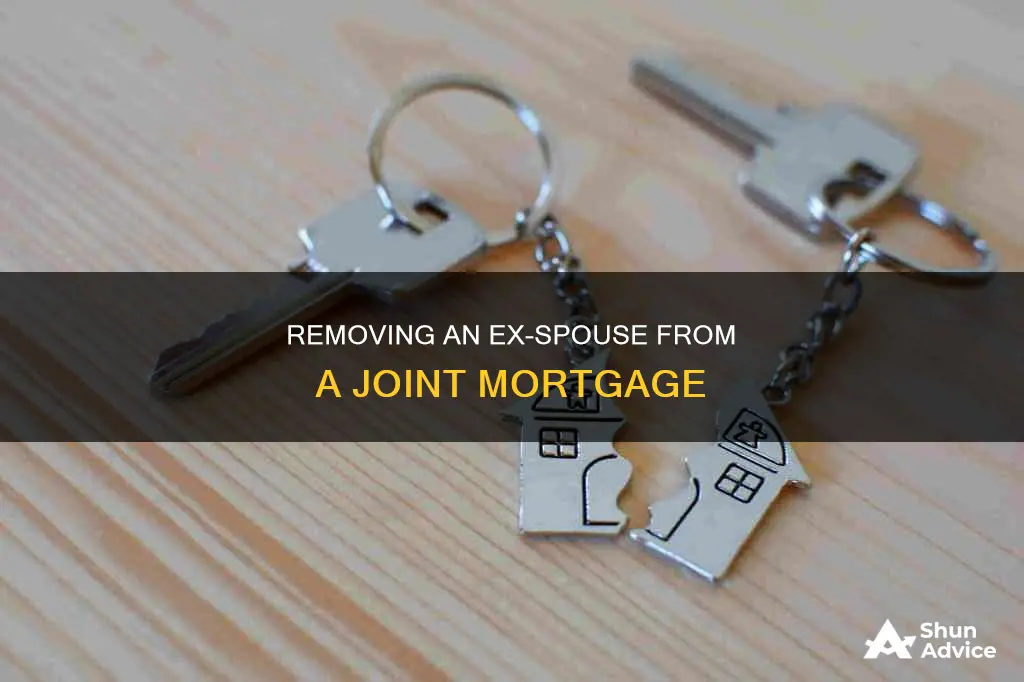
Divorcing your spouse means dividing your assets, including your home. While a divorce decree may grant you ownership of your marital home, it doesn't mean your ex-wife's name is automatically removed from the mortgage. To do this, you can refinance the mortgage in your name only, take over the mortgage through a loan assumption, sell the property, or pursue a legal settlement. Each option has its own challenges, from the potential costs of refinancing to the complexities of selling a jointly owned home. In any case, it's important to understand the financial and legal implications of removing your ex-wife from your mortgage.
Removing an Ex-Spouse from a Mortgage
| Characteristics | Values |
|---|---|
| Options | Refinancing, Loan assumption, Selling the home, Legal settlements, Quitclaim deed, Loan modification |
| Refinancing | Requires a new mortgage to pay off the existing one, releasing the other party from their obligation |
| Loan assumption | One party takes over full responsibility for the mortgage with the lender's approval |
| Selling the home | Requires selling the property to remove the obligation from both parties |
| Legal settlements | Consulting a family law attorney to provide guidance and assistance |
| Quitclaim deed | A document used to transfer property ownership from one person to another without any warranties of title |
| Loan modification | Allows you to change the terms of your mortgage loan without refinancing |
What You'll Learn

Refinancing the mortgage
It is important to note that refinancing does not automatically remove your ex-wife's name from the house title, and she may need to take additional steps to give up her ownership rights. Additionally, refinancing may result in a higher interest rate than when you borrowed together. It is recommended to get a second lender's estimate for a new mortgage in your name only, which will likely involve a credit history check and a background check.
Before refinancing, it is wise to first talk to your current lender or mortgage holder. They may be able to quickly determine whether they will finance a new loan in your name only and on what terms. You can also explore alternatives to refinancing, such as loan assumption, loan modification, or selling the property. However, these options may have their own requirements and limitations, and it is important to carefully consider all options before making a decision.
Making Mortgage Payments: Wells Fargo Guide
You may want to see also

Loan assumption
When going through a divorce, it is necessary to separate your shared property and finances from your ex-spouse. One of the ways to do this is through a loan assumption, where one party takes on full responsibility for the mortgage with the lender's approval. This option is not always available and depends on the original loan terms and lender policies.
Mortgage assumption, or loan assumption, allows a buyer to take on the original loan balance, including the terms and interest rate, but it does not account for any home equity the seller has built. This means that if the house has gained value since the original loan was issued, the buyer must compensate the seller for the difference. For example, if the seller has a loan balance of $300,000 on a house worth $435,000, the buyer will need to pay $135,000 to cover the equity.
There are two distinct ways to assume a mortgage: novation and simple assumption. Novation is the safest type, where the lender agrees to let the buyer take responsibility for the existing mortgage, and the lender releases the seller from future responsibility for the mortgage payments. Simple assumption is a private transfer of responsibility from the seller to the buyer without the mortgage lender's approval, which is a riskier transaction.
To assume a mortgage, the buyer must typically be creditworthy and meet the lender's requirements, such as providing income statements, asset lists, and creditworthiness to ensure they can make the minimum monthly payments. The cost of assuming a mortgage varies and depends on the investor and lender, but it is typically based on a percentage of the unpaid principal balance or a flat amount.
It is important to note that a loan assumption is not free and may cost around 1% of the loan amount plus administrative fees. Additionally, lenders that agree to a loan assumption may require evidence that the remaining borrower can afford the payments, and your ex-spouse may need to consent to the assumption.
Removing a Co-Borrower from Your Mortgage: What You Need to Know
You may want to see also

Loan modification
If you want to remove your ex-wife from your mortgage, you may be able to do so through a loan modification. Loan modification allows you to change the terms of your mortgage loan without refinancing. It is typically used to lower the borrower's interest rate or extend their repayment period to make the loan more affordable. While lenders usually only allow loan modifications in cases of financial hardship, some may accept divorce or legal separation as a valid reason for a loan modification.
Another option is a mortgage assumption, a special type of transaction in which one person takes on or "assumes" sole responsibility for an existing mortgage loan. In the case of divorcing spouses, assumption can release one person from the loan so that the other becomes the sole homeowner. However, not all loans are assumable, so checking with your lender is crucial.
If neither spouse can independently maintain the mortgage, selling the home may be the most practical option. Once the home is sold, the mortgage will be paid off, and both parties will be freed from the joint debt.
It is important to protect your credit score throughout the process of removing your ex-spouse from the mortgage. Ensure that mortgage payments are made on time until your ex-spouse's name is officially removed, as missed payments can negatively affect your credit score.
Putting Your Mortgage Deed in a Trust: What You Need to Know
You may want to see also

Selling the property
If you are considering selling the property, it is essential to seek professional guidance to protect your interests. A real estate agent can provide valuable advice on preparing the home for sale, pricing it appropriately, and navigating the selling process. Additionally, a family law attorney can help ensure that the sale aligns with the terms of your divorce settlement and that your rights are upheld.
It is worth noting that selling the property may not always be the fastest option, as it depends on market conditions and the demand for similar properties in your area. In a strong market, you may be able to sell the property quickly and for a good price. However, in a weaker market, it may take longer to find a buyer, and you may need to consider making repairs or improvements to increase the property's value and appeal.
Overall, selling the property can be a viable option to remove your ex-wife from the mortgage, but it requires careful planning and consideration of the potential challenges and emotional implications.
Paying Off Your Mortgage: Strategies for Financial Freedom
You may want to see also

Quitclaim deeds
A quitclaim deed is a legal document that transfers a person's interest in a property to another party. It is a fast way to transfer ownership of property without any warranties of title. In other words, it does not guarantee that the grantor (the person transferring the property) has a valid ownership interest in the property.
The process through which owners quit the claim on their properties is called a quitclaim deed. This type of transfer makes no seller guarantees. The buyer of the property accepts the risk that the deed's grantor may not have a valid ownership interest. Quitclaim deeds are typically used to transfer property in non-sale situations, such as transfers of property between family members. They can also be used to add or remove a spouse from a property title after divorce.
In a divorce scenario, a quitclaim deed is significant because it simplifies the transfer of real estate ownership. By signing a quitclaim deed, one spouse may quickly cede their share of the property to their ex-spouse, effectively removing their name from the title. This is often more straightforward than selling the property or using other, more complex transfer methods.
However, it is essential to note that a quitclaim deed does not release the grantor from the mortgage obligation if both spouses' names are on the mortgage. Therefore, if you transfer your interest in the property to your ex-spouse through a quitclaim deed, you will still be liable for mortgage payments unless further steps are taken to remove your name from the mortgage itself. Additionally, quitclaim deeds do not bind lenders, and they can pursue both parties for any debts owed.
Mortgage Freedom: Marking Your Loan as Paid Off
You may want to see also
Frequently asked questions
There are several ways to remove your ex-wife from your mortgage, including refinancing, loan assumption, loan modification, selling the property, or using a quitclaim deed. Refinancing is the most common method, but it may come with additional closing costs and the challenge of qualifying for a new loan.
Refinancing involves obtaining a new mortgage to pay off the existing one, releasing your ex-wife from her obligation. To refinance, you can start by talking to your current lender or mortgage holder, who may be able to give you a quick answer about financing a new loan in your name and the terms. You can also shop around and get a second lender's estimate, which will likely require a credit history check and a background check.
A quitclaim deed is a document that transfers property ownership from one person to another without any warranties of title. While a quitclaim deed removes a person's name from the property title, it does not release them from the mortgage obligation if both spouses' names are on the mortgage. In some cases, a quitclaim deed may be signed at a closing in front of your lender, who will notarize the deed and file it with the county clerk.







